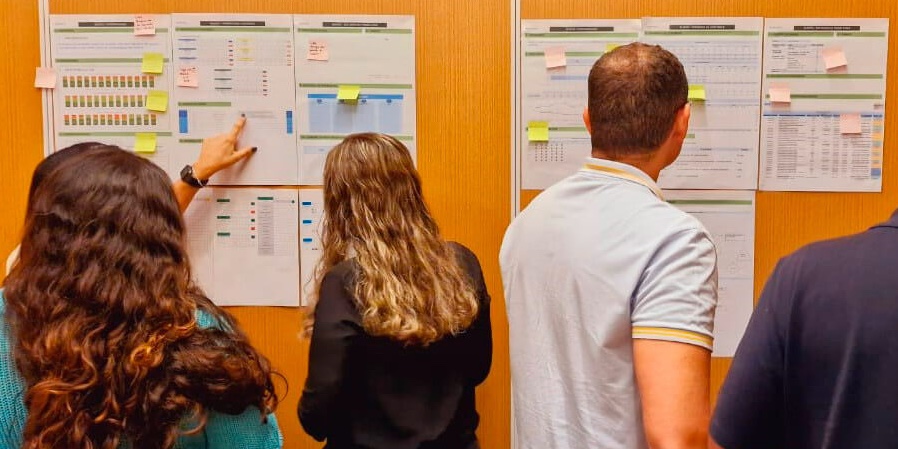
Lean government: how UK courts and tribunals are changing
CASE STUDY - HM Courts & Tribunals Service has been using lean ways of working for over six years, learning many lessons along the way and achieving some fantastic wins.
Words: Julie McGrory, Head of National CI Team, HM Courts & Tribunals Service, United Kingdom
Like all organizations that embark on a lean journey, we have changed our approach many times as our knowledge and experience have increased. We recently celebrated passing "tipping point," but we are still some way from embedding lean across the whole organization of 17,000 people and over 500 sites.
During our latest lean relaunch, HM Courts & Tribunals Service saw the need to engage people more effectively. So we moved away from a tools-based approach (which had created Standard Operating Procedures for every process we had) and began to use visual management. We focused on getting the message across that lasting change only comes with high levels of employee engagement. Indeed, the best examples of lean working well are where the traditional command-and-control approach has been replaced with a consultative leadership style.
We worked really hard to build capabilities, to develop our own learning material, and to teach our people problem-solving skills. We began to put lean principles into context for people. Simplifying the lean language helped us break down barriers and we coached our people to see the advantages of applying lean - for them and for our customers.
To find more meaningful ways to develop HM Courts & Tribunals staff, the lean team looked at the UK's Chartered Institute of Personnel and Development's approach to teaching adults and applied that method to developing learning material. We have written 12 practice-focused modules so far, including problem solving, customer value, go-see, influencing your team and failure demand. There is even one on how to engage people around a visual management board.
This targeted approach to responding to people's needs is really beginning to pay off.
Our approach is founded on deep respect for people, and trusting them to improve processes through problem solving. That's the only way to really sustain results in a complex, ever changing environment.

CHALLENGES TO CHANGE
What are typical problems we encounter in government? It's almost certainly delays, backlogs and the service failure they can lead to.
Helping people understand their customers' needs and expectations is also a challenge. It's all too easy to "firefight" instead of taking the time to step back, analyze the problems, and put sustainable solutions in place.
This stems from deeply entrenched ways of working, coupled with the belief that dealing with the work in front of you must always be the priority. Most people need some help to see that by taking the time to identify what could be improved, we will be able deliver better solutions for our customers. We help leaders see the need to change by sharing relevant examples and showing them what good looks like.
IMPROVING OUR PROCESSES
At HM Courts & Tribunals Service we have done a lot to improve our processes. Looking at things end-to-end from the customer's perspective has indeed led to dramatic changes in many of our sites.
For example, one court wanted to improve the way witnesses can give evidence. Everyone involved in the system - from police, crown prosecution service, witness service, prisons and probation - worked together to identify the problem and possible solutions. Working together, we established that in certain cases video link would be a better way of taking evidence. By helping those agencies involved to see the problem, we have been able to fix it together, using new technology to improve the service for our customers. And by enabling some of our agency partners, such as the police, to give evidence remotely they are saving valuable time.
In another example, the Probate Registry in Newcastle improved their workload management dramatically. They introduced simple technology to enable staff to take control of their day, while easily capturing failure demand to support improvement activities. This is called the electronic Team Information Board (eTib). It combines the introduction of a pull system with an electronic compiler. This records the work in real time and places responsibility of recording the work on each team member.
The system identifies the priorities of the day and marks them in order of importance on a shelving system. Members of the team "pull" work in batches, and once it's done they record it on their compiler. This gives visibility over the workflow.
As a result, teams are more empowered and multi-skilled, morale is higher, team leaders can focus on coaching, and problems like cherry picking are disappearing.
We are now in the process of piloting the tool in other jurisdictions. Our pilot sites met recently and not one voted to go back to the old system. The new "pull" system delivers such high customer value and their backlogs have been reduced dramatically.
Here are some of the quotes we gathered from the pilot sites:
"We use a buddy to train on the spot, which has stopped the need to sort work into piles of what each team member can and can't do. Training kept being put off because we were fire-fighting, but the mixed batches have overcome this and improved the capability of the office."
"It's not until my team saw the results from the compiler that they realized that our workload had changed from 20 years ago and it made them focus in a whole new way."
"The focus on value added and non-value added tasks made us question each job and what value it was providing to the customer."
"The system supported me during difficult conversations with the team, particularly helping one member of staff see that their entire role was rework."

In common with many large organizations, we often see people working in silos, with no idea of how the value flows across the business (or of how old a piece of work is by the time it gets out of the door). At HM Courts & Tribunals Service we are teaching people how their work fits into the bigger picture, encouraging them to take a step back and reflect on the purpose of what they do every day.
And it works. In the courts that are most advanced on their lean journey, judges are getting involved too. In some of our sites, they have begun to use visual management to manage the work in their courtrooms. Because lean supports the idea of not making decisions quickly, but making the right, evidence-based decisions, I guess it fits well with the way a judge thinks. We also have stakeholders attend our 10-minute meetings on a rota in many of our sites, and they really contribute to planned work conversations and to help overcome problems the site faces on a daily basis, such as ensuring the start times of courts work well for all the agencies and customers attending court to allow everyone to be in the right place at the right time.
ASSESSING MATURITY
A big part of applying lean to an organization as large as HM Courts & Tribunals Service is assessing the level of maturity of all our sites. To do this we have a tool that tells us where each of them is on its lean journey.
In this framework there are several questions that help a site understand where they are currently (Getting started, Developing, Practicing, Sustaining, Transformation) by referring to a number of different elements (customer value, strategy deployment, people and capabilities, leadership and lean tools).
It turned out that when you drop an engagement tool into a command-and-control environment, there's a risk that people will treat it in a command-and-control way!
We had to re-draft the tool and coach people in how to use it more clearly, and only now are we at the point where people are starting to use a coaching approach; asking their team a set of questions to understand where the site is on its road to lean. If the answers are satisfactory, the site can move to the next level in the framework. If they aren't, problems are highlighted and an action plan is created.
We used to have a lot of teams racing across the page, maturity level by maturity level, and ticking all the boxes without really owning those behaviors. Today, many have even started moving backwards as they recognize they have not done certain things well enough.
More elaborate lean techniques are gradually gaining momentum. We are seeing increasing interest in things like strategy deployment (traditionally difficult to apply in an environment like ours) as more and more people decide to make lean their way of working. This is particularly true in the operational arm of the business, where staff get a lot of value from using these principles.
We are currently working to create a Lean Dashboard, which will eventually replace the assessment tool. It will have three general areas: people issues (how well we are looking after people, how engaged they are, etc.); performance for customers (bridging the gap between HQ and operational arm, workload and value streams, etc.); and leadership.
WHAT IT TAKES
None of this is possible without support from our people. Our role is to coach, help leaders to see, and help people to thrive.
Lean has tremendous potential to transform the way things happen. If only I had known this when I was first started running courts! Lean principles have been the biggest learning of my life and now I would always use them.
It's also good to see that our efforts are changing the way people think for the long term. Many have been telling me they will never stop using our boards or having that 10-minute meeting at the beginning of each working day. It is as though we have suddenly given people permission to solve problems.
THE AUTHOR

Read more


FEATURE – In this frank account, a senior executive discusses the challenges facing an oil and gas company as it tries to manage the complexity of its upstream and downstream supply chains.


ROUNDUP – This month, we look at the most effective lean improvement approach – kaizen – by looking back at some of our best articles on the subject.


CASE STUDY – Learn how Knauf, a global provider of prefabricated materials, regained its sales leadership in Brazil, impressively optimized its performance indicators, and transformed people's mindset and behaviors.


FEATURE – Kanban is the best-known method to establish pull production, but it is not the only one. Here’s a few other ways you can create a pull system.

